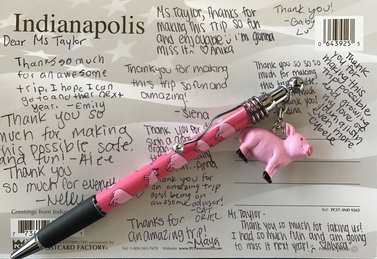 My publications students gave me this postcard after we attended the fall National High School Journalism Convention in Indianapolis. Conventions like this bring students who are already engaged in journalism together, but how can we get the rest of the school excited? My publications students gave me this postcard after we attended the fall National High School Journalism Convention in Indianapolis. Conventions like this bring students who are already engaged in journalism together, but how can we get the rest of the school excited? I wish journalism was a required core subject. I wish we could help every high school student dive into the process and joy of determining what is newsworthy, learning what constitutes good reporting versus repeating rumors, developing the confidence to interview adults and peers and ask hard questions, considering the foundational pillars of ethical journalism, writing and editing and editing and editing and proofreading until an article is truly clear, and learning all the other skills and ways of thinking that happen naturally when a student is actively engaged in news-production. Since every student at the school can't be on staff, however, how can we get the rest of the school engaged in news?
0 Comments
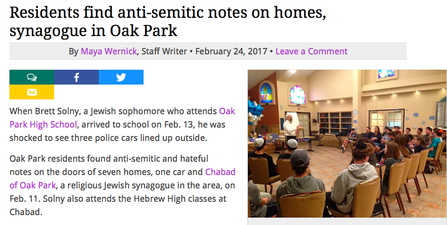 A screenshot of a recent article about anti-Semitic messages in a local community by one of my student journalists. I’ve challenged my reporters to think about how they can move from conveying information to helping readers’ understanding. A screenshot of a recent article about anti-Semitic messages in a local community by one of my student journalists. I’ve challenged my reporters to think about how they can move from conveying information to helping readers’ understanding. My student newspaper staff has a dilemma: how can they get their peers to read the paper when so much of the information in our articles is already known? They are coming up against a problem professional journalists have been struggling with for years. In the old days (I won’t call them good, as I think that’s always relative), news producers — whether newspaper, radio or broadcast — were the source of information. News consumers found out about terrorists attack and new government policies when they opened the morning paper or turned on the evening news. With the advent of the Internet and social media, however, those gatekeepers lost control. Now people have more information than they know what to do with. This flood of data creates a number of problems — especially in terms of helping people separate fact from fiction — but I want to focus today on the issue it creates in terms of engagement. 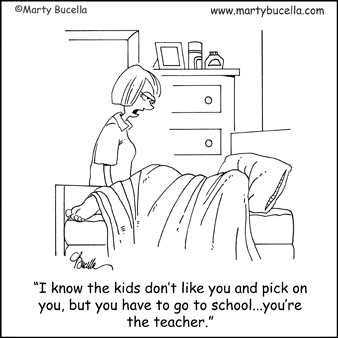 Since this comic by cartoonist Marty Bucella was originally published, it has inevitably popped up on my teacher-friends' Facebook feeds around this time of year. It’s easy to see why—it’s a clever cartoon that turns a cliche on its head while capturing an undeniable truth: teachers sometimes dread school mornings as much as students. Every time I see it, this comic makes me laugh. What teacher hasn’t been here? Who hasn’t wanted to hide under the covers and throw a temper tantrum rather than get up to go to work? It’s funny because it’s true. It’s also endemic of a back-to-school malaise common among both students and teachers that is especially prevalent in middle and high school. It’s cool to dread going back to school. It’s funny. No, really, it’s funny. This isn’t a post meant to scold anyone about making back-to-school grief jokes or to imply there’s anything wrong with them. I’m the first to shield my eyes and wail, “NOOO!” when I see the initial “Back to School Sale” sign go up, and I have a great time bemoaning the pre-dawn alarm clock. I’m a fan of Bucella’s work and love this strip. There is nothing wrong with a little gallows humor about facing the daily grind again after eight weeks of sunshine and freedom, but as much as I might be tempted to erect a faux headstone (“R.I.P. Summer 2015: Gone Too Soon”), I decided to use this post as a way to remind myself why I picked this profession in the first place. It’s not, despite what some pundits might think, because of the summer off. I teach because I love it, and that love means I can’t help but retain a bit of that kindergarten excitement about the first day—even after 18 years in front of the class. It may not be as funny to blog about my back-to-school enthusiasm, but I think it’s important to share our joy and anticipation along with making jokes about wanting to wear mourning on the first day back. So what am I looking forward to? The smell of a freshly cleaned school. The almost blinding whiteness of my whiteboard (which will not be this color again until next year). The incredible possibility of a blank planner. The feeling of accomplishment when I finish each class syllabus. Buying new school supplies—especially getting new pens (particularly after I'd found my One True Grading Pen). Setting up my classroom and seeing it, just this once, perfectly neat and organized. My student editors’ excitement during our Saturday retreat as we plan for the first journalism class, which they will help to lead. The excited squeals of teenagers seeing each other for the first time in two months on the first day of school. Getting hugs from last year's students who stop by just to say hi or to tell me about their summers. Watching each class come in, new faces and personalities and skills to discover. Learning their names and finding out what motivates them. Knowing I will make a difference to at least a few of them. As the year goes on, experiencing these initial joys deepening and becoming more complex. Developing class jokes, bonding over books we love (or love to hate), and debating the ethics behind controversial articles in the paper. Seeing students who were convinced they couldn’t write discovering that maybe they can. Shy students in my journalism class learning to introduce themselves confidently before interviewing a complete stranger. Students in my lit classes who thought they hated to read finding one poem, or one short story, or one article, or (maybe!) more than one book that speaks to them. Hearing them share this with the class with something between disbelief and revelation. I will always laugh when I see a comic about teachers dreading the first day of school because there’s truth to it. Summer is rejuvenating, and it’s hard to shift from flip flops to sensible shoes. It’s a hard job. I seldom put in fewer than ten hours on a school day, and I usually reserve at least four hours on the weekend to catch up on grading. Sometimes the stress of planning and grading and worrying about students or parents or policy can be overwhelming. But it’s also the best job. I think it’s cool to admit we’re all a little excited about that. For more inspiration...If you are a teacher and you are in need of some inspiration, watch this wonderful TED talk from veteran teacher Rita Pierson. She starts her talk saying, "I have spent my entire life either at the schoolhouse, on the way to the schoolhouse, or talking about what happens in the schoolhouse,” and her talk explores the key to a happy life in that schoolhouse: relationships. "Teaching and learning should bring joy,” Pierson says. "Is this job tough? You betcha. Oh God, you betcha. But it is not impossible. We can do this. We're educators. We're born to make a difference.” 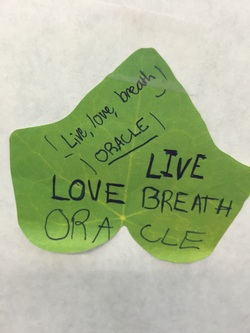 One of the "leaves" on the Gratitude Tree shows the students' thankfulness not only for each other, but also for their shared passion. The Oracle is the student news website this class maintains. One of the "leaves" on the Gratitude Tree shows the students' thankfulness not only for each other, but also for their shared passion. The Oracle is the student news website this class maintains. One of the most important things I've learned as a journalism teacher is the critical need for team-building. Choosing to take journalism as an elective means choosing to do a lot of work outside of class, so the students have to be fully invested in the product. Creating that investment is a multifaceted process. It starts with purpose: creating a shared sense of "this is important." But if we want our students to understand that this the important task cannot be accomplished alone, we also need to make them a team. Teams look out for each other. Teams help each other overcome obstacles and motivate each other when motivation is low. Teams get done what individuals cannot. Teampedia is a great place to start. It is a "collaborative encyclopedia of free team building activities, free icebreakers, teamwork resources, and tools for teams," and it's one of the first places I go when I'm looking to build community. When I decided recently that I wanted another way to reinforce the "news family" aspect of my journalism class, one of my colleagues suggested creating a "kudos board" where students could leave each other shout-outs. I combined this idea with Teampedia's "Thankfulness Tree" activity to create my journalism Gratitude Tree. I wasn't sure if a group of high school students would go for something like this or just write it off as cheesy, but it's been enormously popular and provided a much needed boost in morale and motivation in the final months of the school year. Although I've been using this for journalism, I can think of many ways a tree like this could build community in any setting. It could be an Idea Tree (students could add "leaves" with great ideas they've gotten from each other) in any academic class, for example. It could even be adapted for families to use at home: a Family Gratitude Tree to remind us why we are thankful for each other. We are so busy that it's easy to forget to say thanks, and this provides a forum and physical reminder of that gratefulness. As you can see from the students' messages, it's become a source of tremendous joy in my class. Not a day goes by without someone adding a post-it or two. When the tree gets too full or post-its start falling off, the students will get to keep their leaves as a tangible reminder of their importance to the class. For images of this work-in-progress, check out the gallery below. I commute from one side of the city to the other every morning through Los Angeles' epic rush hour(s) traffic, so I spend a lot of time in my car. And as much as I love NPR news, there is only so much time I can spend listening to Morning Edition and All Things Considered before I am hungry for something else. A few years back I started exploring and subscribing to podcasts, and they've had an added benefit: not only do they entertain me during the long ride, they often inspire my lesson planning. Many of my favorites are also NPR radio shows, but the podcast format has allowed me to broaden my options outside rush hour. The podcast Serial made news this past year when it became the most popular podcast in the U.S., Canada, the U.K, and Australia. This narrative-style investigation of a 15-year old murder case became a "global phenomenon," and some English teachers abandoned their plans and instead had their students listen to the podcast during class and discuss it. KQUD's Mindset recently published an article about the ways teachers are using podcasts in the classroom: "A growing number of educators who are using podcasts like 'Serial' to motivate their classrooms and address education requirements set by the Common Core state standards. Improving students’ listening skills is one of the essential components of the new education mandates, and using audio in the classroom can be an effective way to promote listening." Aside from teaching listening skills, however, my podcast obsession seems to work best to supplement my existing curriculum and broaden our classroom discussions. For example, Radiolab did a fascinating (and somewhat terrifying) episode called "Memory and Forgetting" last year. As I listened to how easily human memory can be manipulated, it hit me: how great would it be to listen to part of this hour with my AP Lit class when we read Orwell's 1984? Or what about using one of the excerpted TED talks featured on the TED Radio Hour in the episode called "Memory Games"? When teaching about the socially constructed nature of race in my American Literature class, the episode "Pike County, OH: As Black as We Wish to Be" on State of the Re:Union became the catalyst for one of the best discussions we had all year. It came up again and again as we read Toni Morrison and Mark Twain. Or to talk about podcasts as an alternative form of journalism in my 21st Century Journalist class, why not listen to the 99% Invisible episode "Under the Moonlight" about how a serial killer in Austin and fears about the dark led to the creation of "moonlight towers"? 99% Invisible is a show about design, so I could also see arts and engineering teachers finding myriad ways to integrate it in their classroom. Trying to help graphic design students understand the power of a symbol? Listen to "Designing a Nuclear Waste Warning Symbol That Will Still Make Sense in 10,000 Years." For that matter, why not use this episode to talk about literary symbolism? My student newspaper Lifestyle editor might benefit from listening to the entertainment roundtable Pop Culture Happy Hour, one of my favorite shows. Could we work this type of a program into our Arts & Entertainment section? I rarely go more than a day without thinking, "I could use that!" Here are some of the podcasts (aside from Serial, which is on hiatus) currently inspiring me. Some of these also broadcast on public radio, but I listen to them all via the podcast app on my phone. What are your favorites? I'd love to hear about them in the comments. 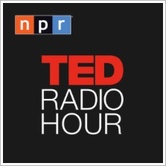 I mentioned in an earlier post how much I love TED talks, and the TED Radio Hour is where I find most of them. Each episode includes approximately five talks around a common theme or topic. The host Guy Raz weaves excerpts from the original talks together with interviews from the speaker. No matter what you teach, this show will have a lot of options for you to explore.  Radiolab mixes science with storytelling and creates magic. This is the show I used to explore memory manipulation in Orwell's 1984, and I get ideas for other literary connections all the time when I listen. If you teach journalism, you must listen to the hilarious podcast extra from "Happy Birthday, Bobby K" in which co-host Robert Krulwich tells an epic tale of chasing the ultimate story involving alligators and a marching band.  State of the Re:Union is a fantastic show for American literature, history and geography. Its slogan is "Telling the story of America, one community at a time," and its homepage features an interactive map of the country. You can click on any state to see stories from that area.  99% Invisible calls itself "a tiny show about design," but because it explores such an eclectic range of topics, it connects to my class in unexpected ways. An obvious must for any design or architecture teacher, but I'd argue you could find a way to connect some of the episodes to almost any subject. 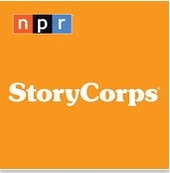 StoryCorps features real stories told by real people. From their site: "Since 2003, StoryCorps has collected and archived more than 50,000 interviews with over 90,000 participants. Each conversation...is preserved at the American Folklife Center at the Library of Congress. StoryCorps is one of the largest oral history projects of its kind." I love it also because you can search the site by theme. About to teach Romeo and Juliet? Have students listen to a few stories about love. Reading How the Garcia Girls Lost Their Accents? Take a listen to real immigration stories. It's a great resource. 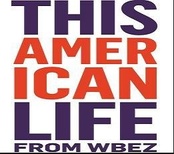 This American Life is in many ways the radio show that started it all. According to its website, it's often the most popular podcast in the country, and for good reason. With fascinating themes, deep investigation, and twenty years of storytelling experience, it's endlessly inspiring. I believe the the recent episode "Three Miles" should be mandatory listening for every teacher--heck, every person--in the country.  Code Switch bills itself as "a team of journalists fascinated by the overlapping themes of race, ethnicity and culture, how they play out in our lives and communities, and how all of this is shifting." I'm cheating a little here since it's primarily a blog, but it's too good to leave off. 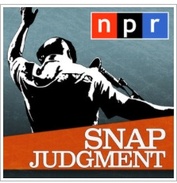 Snap Judgment's slogan is "storytelling with a beat," and it's one of my favorite shows. Each episode has a theme and a mix of fictional and non-fictional stories around that theme. Since every segment is distinct and not too long, it can be a great place to go when I'm looking for a quick story to connect thematically to a book we're reading. As with any of these podcasts, not all stories are appropriate for all grades, but when I find one that works, the students love the way Glynn Washington and his team mix words, sounds and music together.  I probably wouldn't use Pop Culture Happy Hour directly in my classroom (except, perhaps, to inspire my entertainment journalists), but I love it as a way to stay in touch with popular culture--important for a teacher, I think. I also completely adore Linda Holmes and her team. They have a great chemistry and never fail to make me laugh on my way to work Friday morning. |
About“And though she be but little, she is fierce!” -A Midsummer Night’s Dream Archives
December 2020
Categories
All
|
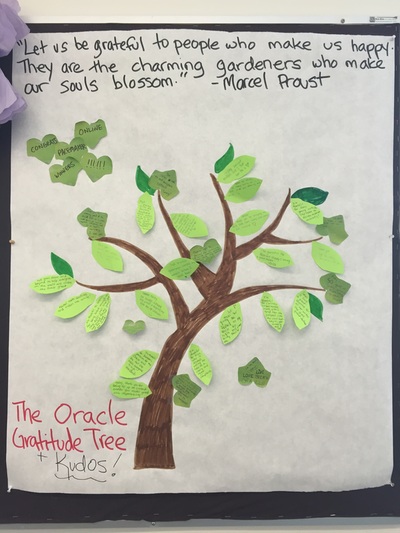
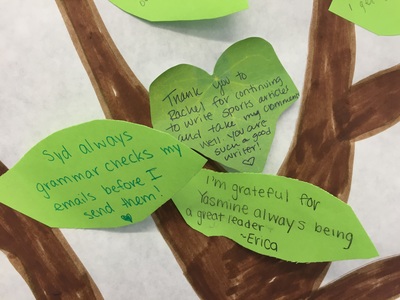
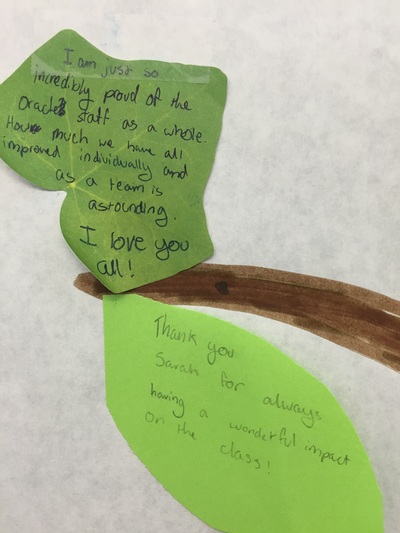
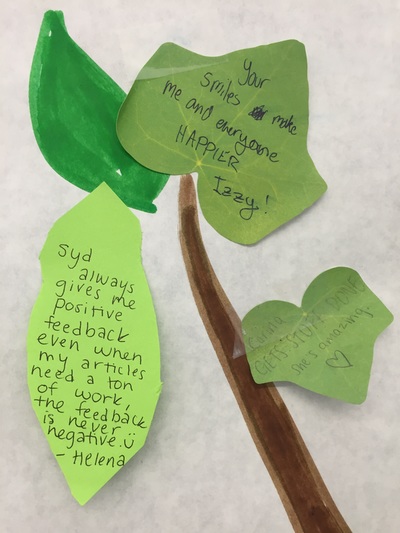

 RSS Feed
RSS Feed